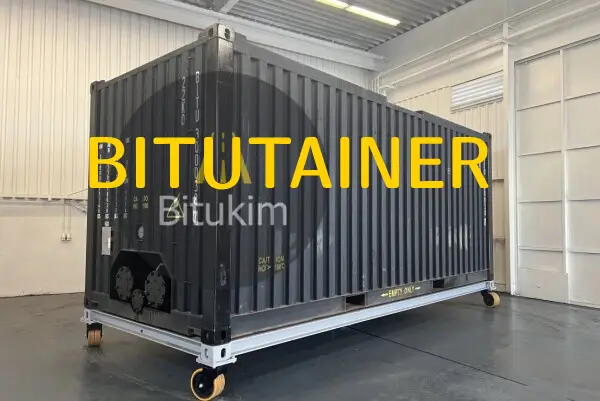bitubox vs bitutainer

Features of a bitubox vs bitutainer
- Box-Type Design:
- As the name suggests, a Bitubox typically comes in a box-like shape, which is made from durable materials such as steel, reinforced plastic, or metal.
- It is used for transporting bitumen in bulk or bitumen-based products (such as bitumen emulsions or polymer-modified bitumen (PMB)) in a more compact, stackable form.
- Temperature Control:
- A Bitubox may come with heating systems or insulation to maintain the required temperature of bitumen during transportation and storage.
- This ensures that the bitumen remains in its liquid or semi-liquid state, preventing it from solidifying or becoming too viscous to use.
- Design for Easy Handling:
- The compact box is designed to be easily handled by forklifts or other lifting equipment.
- It is usually stackable, which optimizes space during storage and transportation, especially for bulk shipments.
- Some Bituboxes come with integrated pallets or lifting hooks for easy unloading.
- Capacity:
- Bituboxes are typically available in varying sizes, depending on the amount of bitumen that needs to be transported. They are generally intermediate in size, falling between the bulk transport capacity of tankers and the smaller quantities packed in drums or containers.
- Common volumes range from 500 liters to 1,000 liters or more.
- Leak-Proof Design:
- These containers are designed to be leak-proof to prevent spillage, which is particularly important for bitumen, given its viscous nature and the risk of environmental damage.
- Safe Storage:
- Bituboxes are used for safe, long-term storage and are designed to maintain the quality and integrity of the bitumen for as long as necessary.
- Some versions may have features such as seals, temperature gauges, and ventilation to ensure proper storage conditions.
Advantages of Using bitubox vs bitutainer:
- Space-Efficient: They allow for compact, stackable storage, saving space both in transport and storage.
- Temperature Control: With heating and insulation, they help maintain the correct consistency of bitumen during transport, preventing it from cooling and solidifying.
- Easy Handling and Transport: They are often designed for ease of loading and unloading, making them suitable for international shipping and distribution to construction or industrial sites.
- Reduced Risk of Leakage: Their robust design and seals reduce the risk of leaks, which is especially important when transporting a material like bitumen that is both highly viscous and environmentally hazardous.
Applications of bitubox vs bitutainer:
- Asphalt Plants: For storing and transporting bitumen in bulk to manufacturing facilities or asphalt mixing plants.
- Road Construction: For transporting bitumen to job sites where it will be mixed with aggregates for road construction.
- Specialized Projects: Bituboxes can also be used for polymer-modified bitumen (PMB) and bitumen emulsions, which are used in paving, waterproofing, or other industrial applications.
Bitubox vs. Other Packaging Solutions:
- Bitubox vs. Steel Drums: While steel drums are commonly used for small-scale shipments, the Bitubox offers a larger, more efficient solution for medium-to-large-volume transport and storage.
- Bitubox vs. Tankers: Bituboxes are more manageable than bulk tankers in terms of loading/unloading and stackability, and they are ideal when smaller quantities need to be shipped or stored.
Bitubox vs Bitutainer : A Direct Comparison
| Feature | Bitubox | Bitutainer |
|---|---|---|
| Capacity | 500 to 1,000 liters (smaller volumes) | 20,000 to 30,000 liters (large volumes) |
| Design | Compact, stackable box with forklift access | ISO standard shipping container for bulk transport |
| Temperature Control | Insulated with optional heating systems | Equipped with insulation and steam/electrical heating |
| Ideal Use | Local or medium-volume transport | Bulk transport for long-distance or international shipments |
| Transport Modes | Truck-based or local delivery | Ship, rail, or road (multi-modal transport) |
| Durability | Durable, leak-proof design for medium-scale use | Heavy-duty, leak-proof for long-distance shipping |
| Cost | Generally cheaper for small-scale and short-term use | More expensive, designed for bulk and international shipments |
| Handling | Easy to handle with forklifts, compact and stackable | Requires cranes or heavy machinery for loading/unloading |
What is a Bitutainer?
A Bitutainer is a specialized ISO container that is designed for the bulk transport of bitumen over long distances. The Bitutainer is essentially a large, insulated shipping container that is specifically equipped to carry bitumen, keeping it at the right temperature during transport.
Key Features of Bitutainer:
- Capacity: Generally holds 20,000 to 30,000 liters or more.
- Design: A bulk container built to ISO standards, meaning it can be stacked and transported via different modes of transport, including ship, rail, and road.
- Temperature Control: Equipped with insulation and heating systems to maintain bitumen’s temperature during transit. Typically uses steam-heating coils or electrical heating systems.
- Material: Made of steel or durable alloys and designed to withstand long-distance shipping conditions.
- Multi-Modal Transport: ISO standard dimensions allow for flexible transport across shipping containers, railcars, and trucks.
Advantages of Bitutainer:
- High Capacity: Ideal for large-scale shipments of bitumen (typically in the tens of thousands of liters).
- Temperature Control: Equipped with heating systems to keep bitumen at optimal working temperatures.
- Multi-Modal Flexibility: Can be shipped via sea, rail, or road due to its ISO compliance.
- Long-Distance Shipping: Designed for international transport, particularly for bulk shipments to asphalt plants, refineries, or large construction sites.
- Durable and Leak-Proof: Built to withstand harsh conditions during long-distance shipping and protect the bitumen from contamination or leakage.
Best For:
- Large-scale shipments of bitumen, typically over long distances or internationally.
- Paving operations, road construction projects, or large-scale industrial applications requiring substantial volumes of bitumen.

